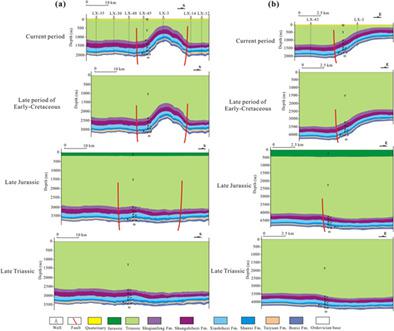当前位置:
X-MOL 学术
›
Geolog. J.
›
论文详情
Our official English website, www.x-mol.net, welcomes your
feedback! (Note: you will need to create a separate account there.)
Tectonic evolution and gas control analysis of the Upper Palaeozoic tight sandstone reservoirs in the Linxing area of the eastern Ordos Basin
Geological Journal ( IF 1.4 ) Pub Date : 2020-10-13 , DOI: 10.1002/gj.4007 Qing Guo 1 , Xuanyi Wang 2, 3 , Shuai Yin 4 , Zhonghu Wu 5
Geological Journal ( IF 1.4 ) Pub Date : 2020-10-13 , DOI: 10.1002/gj.4007 Qing Guo 1 , Xuanyi Wang 2, 3 , Shuai Yin 4 , Zhonghu Wu 5
Affiliation

|
Low‐amplitude structures and volcanic intrusion diapir structures are developed in the Upper Palaeozoic in the LX (Linxing) area, eastern Ordos Basin, China. However, the tectonic evolution of this area and its gas control effect were not clear. In this article, taking the LX area, eastern Ordos Basin as an example, the tectonic evolution and palaeostructure of the Upper Palaeozoic were restored using a large number of drilling, logging, and seismic data. The acoustic wave time difference method was used to calculate the denudation thickness of the unconformity surface (T3y‐Q, Upper Triassic Yanchang Formation‐Quaternary). The calculated results showed that the denudation thicknesses mainly range between 1,000 and 2,500 m. The tectonic evolution model of the Upper Palaeozoic strata since the end of the Triassic period was established using the balanced cross‐section technique, and the palaeo‐tectonic pattern of the target layer in the early stage of the Early‐Cretaceous epoch was restored. The strong buckling tectonic activities of the Zijinshan Pluton provided the main driving force for the deformation of the Upper Palaeozoic rock mass. Finally, the coupling relationship between the ancient and current structural patterns of the target layer, and the distribution of commercial gas wells was compared. The results show that high parts of the palaeo‐tectonic structures are favourable places for the large‐scale accumulation of tight sandstone gas, and the current structure plays a certain role in adjusting the distribution of tight sandstone gas.
中文翻译:

鄂尔多斯盆地东部临兴地区上古生界致密砂岩储层的构造演化与气控分析
鄂尔多斯盆地东部LX(临兴)地区上古生界发育了低振幅构造和火山侵入底辟构造。然而,该地区的构造演化及其对天然气的控制作用尚不清楚。本文以鄂尔多斯盆地东部LX地区为例,利用大量钻探,测井和地震资料,恢复了上古生界的构造演化和古构造。使用声波时差法计算不整合面的剥蚀厚度(T 3 y-Q,上三叠统延长组-第四系)。计算结果表明,剥蚀厚度主要在1000〜2500m之间。利用平衡断面技术建立了三叠纪末以来的上古生界地层构造演化模型,恢复了白垩纪早期目标层的古构造格局。紫金山岩体强烈的屈曲构造活动为上古生界岩体的变形提供了主要动力。最后,比较了目标层的古代构造和当前构造样式之间的耦合关系,以及商业气井的分布。
更新日期:2020-10-13
中文翻译:

鄂尔多斯盆地东部临兴地区上古生界致密砂岩储层的构造演化与气控分析
鄂尔多斯盆地东部LX(临兴)地区上古生界发育了低振幅构造和火山侵入底辟构造。然而,该地区的构造演化及其对天然气的控制作用尚不清楚。本文以鄂尔多斯盆地东部LX地区为例,利用大量钻探,测井和地震资料,恢复了上古生界的构造演化和古构造。使用声波时差法计算不整合面的剥蚀厚度(T 3 y-Q,上三叠统延长组-第四系)。计算结果表明,剥蚀厚度主要在1000〜2500m之间。利用平衡断面技术建立了三叠纪末以来的上古生界地层构造演化模型,恢复了白垩纪早期目标层的古构造格局。紫金山岩体强烈的屈曲构造活动为上古生界岩体的变形提供了主要动力。最后,比较了目标层的古代构造和当前构造样式之间的耦合关系,以及商业气井的分布。









































 京公网安备 11010802027423号
京公网安备 11010802027423号